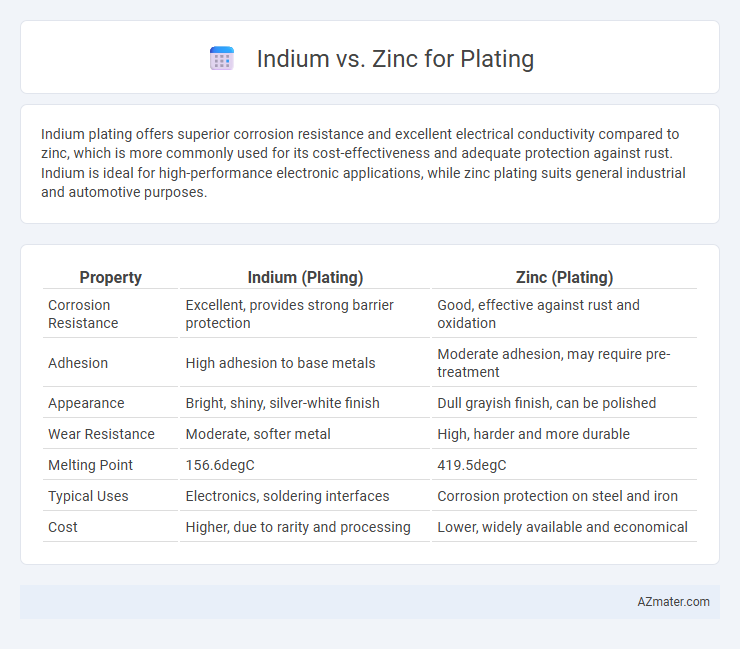Indium plating offers superior corrosion resistance and excellent electrical conductivity compared to zinc, which is more commonly used for its cost-effectiveness and adequate protection against rust. Indium is ideal for high-performance electronic applications, while zinc plating suits general industrial and automotive purposes.
Table of Comparison
| Property | Indium (Plating) | Zinc (Plating) |
|---|---|---|
| Corrosion Resistance | Excellent, provides strong barrier protection | Good, effective against rust and oxidation |
| Adhesion | High adhesion to base metals | Moderate adhesion, may require pre-treatment |
| Appearance | Bright, shiny, silver-white finish | Dull grayish finish, can be polished |
| Wear Resistance | Moderate, softer metal | High, harder and more durable |
| Melting Point | 156.6degC | 419.5degC |
| Typical Uses | Electronics, soldering interfaces | Corrosion protection on steel and iron |
| Cost | Higher, due to rarity and processing | Lower, widely available and economical |
Introduction to Indium and Zinc Plating
Indium plating offers superior corrosion resistance and excellent conductivity, making it ideal for specialized electronics and aerospace applications. Zinc plating provides a cost-effective, sacrificial coating that protects steel and iron from rust, widely used in automotive and construction industries. Both metals serve as protective surface treatments, with indium excelling in precision environments and zinc preferred for broader anti-corrosion purposes.
Chemical Properties: Indium vs Zinc
Indium exhibits superior corrosion resistance and higher malleability compared to zinc, making it ideal for plating applications requiring durability and flexibility. Zinc offers excellent galvanic protection due to its anodic nature, effectively preventing rust on steel surfaces. Chemically, indium is less reactive with acids and alkalis, whereas zinc tends to form stable oxide layers that enhance its protective properties during plating.
Surface Finish and Appearance
Indium plating delivers a smooth, bright, and highly reflective surface finish, making it ideal for applications requiring exceptional visual quality and corrosion resistance. Zinc plating offers a more matte or dull appearance with a characteristic pale gray color, commonly used for its affordability and sacrificial corrosion protection. The choice between indium and zinc plating depends on the desired surface aesthetics and environmental durability, with indium favored for premium coatings and zinc preferred for cost-effective corrosion barriers.
Corrosion Resistance Comparison
Indium plating offers superior corrosion resistance compared to zinc, especially in harsh environments with exposure to acids, bases, and salts. Zinc plating provides effective sacrificial protection by corroding first, which prevents rust on steel substrates but may degrade faster under prolonged exposure to moisture or aggressive chemicals. Indium's inert properties create a more durable barrier, making it ideal for applications requiring long-term corrosion protection and electrical conductivity.
Electrical Conductivity Differences
Indium plating offers superior electrical conductivity compared to zinc plating, making it ideal for applications requiring minimal resistance and reliable signal transmission. Indium's conductivity is approximately 1.2 x 10^7 S/m, significantly higher than zinc's conductivity around 1.7 x 10^7 S/m, enhancing performance in sensitive electronic components. Zinc plating, while providing excellent corrosion resistance and cost-effectiveness, typically results in higher electrical resistance, limiting its effectiveness in high-precision electrical contacts.
Industrial Applications of Indium and Zinc Plating
Indium plating offers exceptional corrosion resistance and excellent solderability, making it ideal for aerospace, electronics, and semiconductor industries where reliable electrical conductivity and protection against oxidation are critical. Zinc plating provides effective, cost-efficient corrosion protection primarily for automotive, construction, and heavy machinery applications, offering a robust barrier against rust and wear. The choice between indium and zinc plating depends on specific industrial requirements such as conductivity, corrosion resistance, and budget constraints.
Environmental and Safety Considerations
Indium plating offers a lower environmental impact due to its non-toxic nature and excellent corrosion resistance, reducing the need for frequent reapplications and hazardous waste generation. Zinc plating, while effective for corrosion protection, often involves toxic chemicals like hexavalent chromium in post-treatment, posing higher environmental and occupational health risks. Choosing indium plating supports safer working conditions and compliance with stricter environmental regulations, promoting sustainable manufacturing practices.
Cost Comparison: Indium vs Zinc
Indium plating typically incurs higher costs than zinc due to the rarity and extraction complexity of indium metal, which drives up material prices and processing expenses. Zinc plating is more economical, benefiting from abundant supply, lower raw material costs, and well-established industrial processes that reduce overall production expenses. When considering plating for corrosion resistance or solderability, zinc remains the preferred cost-effective solution, while indium's premium pricing limits its use to specialized applications requiring unique properties.
Plating Process Techniques and Compatibility
Indium plating involves electrodeposition techniques that provide excellent corrosion resistance and solderability, making it suitable for delicate electronics and cryogenic applications. Zinc plating primarily uses electrogalvanization and offers robust sacrificial protection against rust, ideal for automotive and construction components. Indium's softness and low melting point require careful control in plating baths, whereas zinc plating is compatible with a wide range of substrates and more flexible in industrial-scale batch processes.
Choosing the Right Metal for Your Plating Needs
Indium offers superior corrosion resistance and excellent electrical conductivity, making it ideal for specialized electronic plating applications, whereas zinc provides strong sacrificial protection against rust and is more cost-effective for automotive and industrial use. Zinc plating typically delivers better mechanical durability and easier application processes, while indium's softness and malleability make it suitable for delicate or precision components requiring a uniform, thin coating. Selecting the right metal for plating depends on the specific environmental exposure, mechanical requirements, and budget constraints of your project.

Infographic: Indium vs Zinc for Plating
 azmater.com
azmater.com